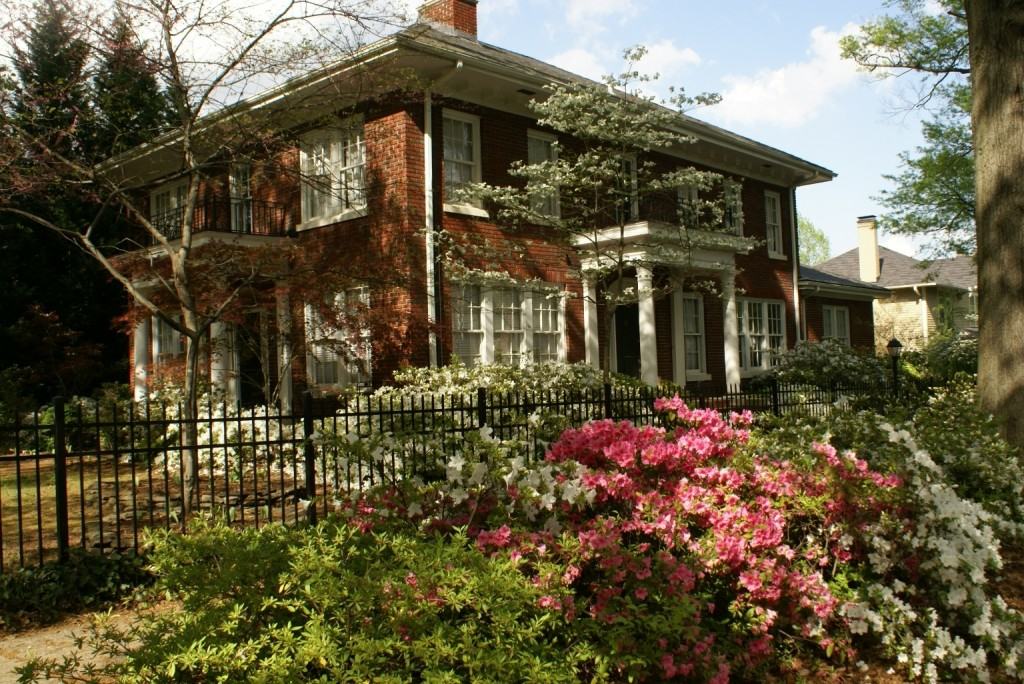 Trinity Park took root in the late 1800s, sprouting in an area of woods and farmland. By that time, the city of Durham, founded in the 1850s, had expanded into a bustling tobacco and textile town, sprawling along the North Carolina railroad. With economic security assured, city leaders began creating amenities needed for a thriving city, including wooing Trinity College to move here from Randolph County in 1891-92.
Trinity Park took root in the late 1800s, sprouting in an area of woods and farmland. By that time, the city of Durham, founded in the 1850s, had expanded into a bustling tobacco and textile town, sprawling along the North Carolina railroad. With economic security assured, city leaders began creating amenities needed for a thriving city, including wooing Trinity College to move here from Randolph County in 1891-92.
The Queen Anne-style homes built for Trinity College professors in 1891–called Faculty Row houses–were among the first new homes. One of them, the Crowell House at 504 Watts Street, wasn’t lavish, but it did have one unheard of luxury–indoor plumbing. The original owner was Trinity College president John Franklin Crowell. Another early structure was the original Watts Hospital, which today stands at 302 Watts. Built in 1895, it was Durham’s first hospital and considered one of the state’s most up-to-date facilities.
A new electric trolley, which connected downtown to west Durham residences, ignited more growth. In 1901, Brodie L. Duke, the brother of Trinity College benefactor James B. Duke, subdivided his extensive property east of Trinity College (now Duke University). The area soon became one of the city’s most fashionable enclaves, with houses in a plethora of styles, including Victorian, Neo-Colonial, period revivals, and bungalows with Craftsman details. Professors, doctors, politicians, and business leaders moved into the stately new homes.
As the city’s economy and university prospered, the neighborhood expanded north of Urban Avenue in the 1920s through the ‘40s, including the construction of more homes for the less well-to-do. As it matured, the 250-acre enclave, which was divided into about 40 blocks, was notable for having a high concentration of the city’s most stylish apartments, as well as stately new churches and schools. An oak canopy shaded the streets, thanks to a 1930s Works Progress Administration planting project.
But in the 1950s, as families began moving to more distant suburbs, the neighborhood slid into decline. Residents who bought cheap, dilapidated houses in the 1960s recall their real estate agents warning them against settling in “Durham’s next slum.” One morning in 1972, resident Max Gray Rogers awoke to city crews chopping down oaks on Trinity Avenue to make way for a four-lane, cross-town thoroughfare, right through the neighborhood.
The road project–halted after intense protests–marked the start of the renaissance. In 1974, under the leadership of Rogers and others, the community formally adopted the name of Trinity Park and organized an association. In 1976, they succeeded in persuading the city to “downzone” much of the area. The change halted the demolition of historic houses to develop more mundane, high-density apartments.
In 1980, residents purchased a large corner lot that was slated for a multifamily dwelling and created a playground. Today, our park features a wonderful gazebo, a gated play area, as well as spacious grassy areas with benches and shade trees. It is the hub of annual activities, concerts, and festivals. A monument in the park, which memorializes the hood ornament on the old Studebaker driven by Rogers, honors his leadership.
But residents haven’t stopped there. Scores of majestic houses–many of them converted into ramshackle apartments during the area’s decline–have been returned to owner occupancy, with residents devoting years to sensitive historic renovations. Some are proudly on display during the periodic home and garden tours.
In 1984, residents worked to document 365 historic structures around the original Trinity College, the area to the north called Trinity Heights, and the southern half of Trinity Park. As a result, the Trinity Historic District was placed on the National Register of Historic Places. In 2004, another application was approved that expanded the National Register district to encompass the rest of the neighborhood, including another 366 historic structures.
Today, both Durham and Duke University continue to grow around Trinity Park, which remains one of the most intact, historic neighborhoods in the Triangle. Trinity Park is located near Northgate Mall, Brightleaf Square, and the Ninth Street Shopping District. Residents have quick access to I-85, the Durham Freeway, and are minutes from downtown Durham.
Trinity Park residents are determined to improve the neighborhood for future generations and are always working to preserve the unique sense of community that is the true charm of Trinity Park.
